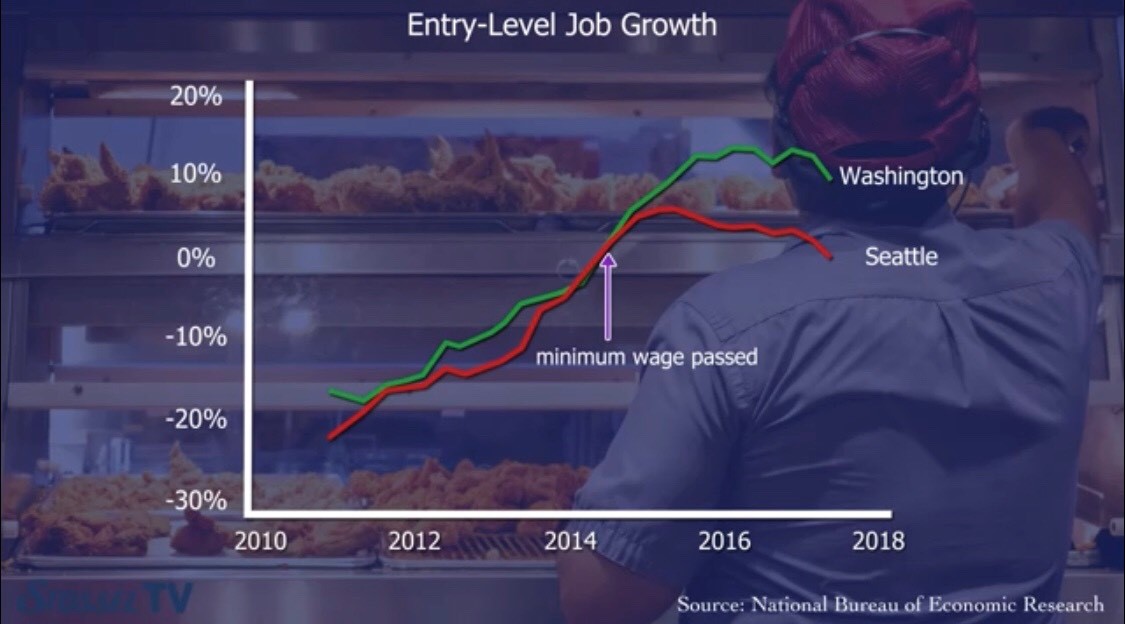This is a summary of an in-depth study, "Right-to-Work: What it is, how it works," available here.
The issue of right-to-work, the right of a person to hold a job without having to pay dues to a union, is steadily taking center stage across the country as states strive to improve their ability to create jobs, promote economic development and attract new businesses. Two states, Indiana and Michigan, recently enacted right-to-work laws, also called workplace freedom or workplace choice, with more states introducing legislation and debating the issue every year. Currently twenty-four states have right-to-work laws.
In states with right-to-work laws, workers can choose not to join a union and not pay dues. States without right-to-work laws do not allow workers that choice, instead requiring employees in unionized workplaces to pay union dues or “agency fees” as a condition of employment. Employees who do not pay union dues can be fired.
A right-to-work law does not prohibit employees from joining a labor union, nor does it prohibit them from paying union dues voluntarily. Labor unions still operate in right-to-work states, but the law protects each person’s freedom of association by prohibiting the payment of union dues from being required as a condition of employment. The principle right-to-work laws seek to protect is that no one should be forced to choose between paying money to an organization or cause he or she might oppose and making a living.
Opponents say right-to-work laws give non-union members a “free ride” in the workplace, enabling them to benefit from union representation and union-secured benefits without sharing in the cost of negotiating those benefits. They argue the “free riders” ultimately lead to more and more workers leaving the union, undermining the stability and financing of the union itself. For that reason opponents often describe efforts to pass right-to-work laws as “union-busting.” Opponents claim federal law requires unions to represent all workers at a company, whether or not they pay union dues, leaving unions in right-to-work states in an unfair position.
The following sections examine the most common questions asked about right-to-work laws and provide factual answers.
Do right-to-work laws improve a state’s business climate?
Yes. Studies show that states with right-to-work laws attract more new businesses than states without such laws.
Right-to-work status is considered a major factor in a business’s decision about where to locate. Professional site consultants say a right-to-work law is at the top of the list of factors companies consider when picking a state in which to do business, and that 50% of manufacturers automatically screen out any non-right-to-work state.
Nationally, the top three states for new manufacturing jobs are right-to-work states (Michigan, Texas and Indiana), and four of the five top states for total manufacturing jobs are right-to-work states (Indiana, Arkansas, Michigan and Alabama). In the period before Indiana and Michigan passed right-to-work laws, the 22 states with right-to-work laws saw their share of nationwide automotive manufacturing output increase from 36% to 52%. Real manufacturing GDP in those 22 right-to-work states grew by 87% during that decade, but fell by 2% in non-right-to-work states.
Do right-to-work states have lower unemployment?
Yes. A report by the Congressional Research Service found that in the past decade, “aggregate employment in right-to-work states has increased modestly while employment in union security states has declined.” Other studies echo these findings. Both employment growth and manufacturing employment growth have consistently been higher in right-to-work states compared to non-right-to-work states over the past two decades.
The average unemployment rate of right-to-work states is typically around 10% percent lower than in non-right-to-work states.
Does passing a right-to-work law improve job opportunities?
Yes. One economic study found that, “incomes rise following the passage of right-to-work laws, even after adjusting for substantial population growth that those laws also induce. Right-to-work states tend to be vibrant and growing; non-right-to-work states tend to be stagnant and aging…the overall effect of a right-to-work law is to increase economic growth rates by 11.5%.” Right-to-work
states consistently outperform non-right-to-work states in employment growth, population growth, in-migration and personal income growth.
For example, after Michigan passed a right-to-work law in December 2012, the state’s unemployment rate dropped from 10.4% (in 2011) to 8.7% (in 2013). Michigan’s governor predicts the state’s growing auto and auto parts production will cut unemployment to 8.3% in 2014, 7.5% in 2015 and 6.7% by 2016.
Does right-to-work mean work-for-less?
No. Opponents of right-to-work laws disparagingly refer to them as “right-towork-for-less” laws. They claim workers in right-to-work states earn lower wages than workers in other states.
Right-to-work states do have lower average wages than non-right-to-work states, but a comparison based on raw numbers does not account for state economic conditions. Importantly, right-to-work states generally have a significantly lower cost of living than non-right-to-work states. In the first quarter of 2014, 20 of the 25 states with the lowest cost of living were right-to-work states.
When a fair comparison based on true cost of living is made, workers in right-to-work states have higher real disposable incomes than workers in non-right-towork states.
Do unions have to represent “free riders” who do not pay union dues?
No. Federal law does not require unions to represent non-members. Under federal law, unions are allowed to bargain solely on behalf of their own dues-paying members, and no one else, under a “members-only” contract. The benefits secured under these contracts apply only to dues-paying union members.
Unions are only required to represent every worker, even non-dues-paying members, if union executives choose to invoke federal law giving them the privilege of “exclusive bargaining representation.” This monopoly bargaining position allows unions to represent and negotiate on behalf of all employees in a company, regardless whether every employee wants that representation. If unions insist on securing exclusive representation for themselves, the law then requires them to negotiate fairly on behalf of all workers.
If a union decides against exclusive monopoly bargaining, and chooses instead to negotiate only on behalf of its own members, it is not required to represent nonmembers. In practice unions almost always seek exclusive bargaining status, since it gives them a monopoly position in the workplace. Unions then use that choice as justification for forcing employees to pay for representation they may not want.
Is right-to-work “union-busting?”
value to workers and establish a voluntary relationship with them. A voluntary relationship forces union executives to be more responsive and accountable to workers and to do a better job.
In general, union membership is lower in right-to-work states. But right-towork laws do not necessarily translate into lower union membership. Many unions have maintained strong membership in right-to-work states. Union executives must simply work harder to keep their members happy and satisfied. If a union loses members after passage of a right-to-work law, it is not because the law required that result; it is because workers exercised a choice they didn’t have before.
Does giving workers right-to-work choice reduce union membership?
Not necessarily. The extent to which union membership has declined in right-to-work states because of right-to-work laws is questionable, considering the longterm national decline over the same time period. Nationally, the rate of union membership has declined 43.8% since 1983.
In the four states that have become right-to-work in recent decades—Idaho in 1985, Oklahoma in 2001, Indiana in 2012 and Michigan in 2013—the decline in union membership has not been nearly as precipitous as claimed by right-to-work opponents, when the general decline in national union membership is taken into account.
- Idaho: Union membership has declined by 47% since becoming right-to-work; during the same time period the national rate of unionization declined by 40%.
- Oklahoma: Union membership has increased 10% since becoming a right-to-work state, while the national rate declined by 17%.
- Indiana: Union membership has declined 17%, compared to the national decline of 5%.
- Michigan: Although only a right-to-work state since 2013, union membership has declined 1.8% from 2012 to 2013, while the national rate has declined by 5%. While most right-to-work states have union membership rates lower than the national average, many right-to-work states still have high unionization rates, and some non-right-to-work states have low unionization rates.
Have unions filed lawsuits to overturn right-to-work laws?
Yes. As more states consider passing right-to-work laws, labor unions in Indiana have met with some success in mounting a legal challenge to that state’s new right-to-work law.
After two state courts ruled against the law, the Indiana Supreme Court is set to hear arguments on the case in September 2014. In Michigan, a state appeals court upheld the right-to-work law and a federal district court upheld the core components of the right-to-work law; it is now under consideration by that state’s supreme court. The Oklahoma Supreme Court rejected two attempts by labor unions to overturn that state’s right-to-work law in 2004.
In general, any state that passes a right-to-work law can expect an immediate legal challenge from organized labor interests.
Does this year’s Harris v. Quinn ruling affect right-to-work laws?
Yes. The U.S. Supreme Court’s recent ruling in Harris v. Quinn may lead to all states becoming right-to-work for government employees. In July 2014, the court ruled that Illinois home health care workers cannot be forced to join a union or pay “agency fees” or dues. In Harris, the court ruled that, because those workers are hired and paid by state-subsidized individuals, they are “partial public employees” and are not subject to a law that allows public sector unions to collect mandatory union dues, or agency fees, as a condition of employment.
The Harris ruling could impact hundreds of thousands of forcibly unionized home health care workers in California, Oregon, Massachusetts, Minnesota, Vermont, Connecticut and Washington. Already, Illinois has agreed that the ruling means state-subsidized home day care providers cannot be forced to pay union dues, known as “fair share fees.”
In another U.S. Supreme Court ruling in 2012, Knox v. SEIU, the justices indicated the First Amendment freedom of association of workers forced to pay dues to an organization are not being protected.
The Harris and Knox rulings could be the foundation for overturning a previous court decision, Abood v. Detroit Board of Education, which set the precedent in 1977 that allows government employees to be required to pay union dues or agency fees for representing them, even if they do not want that representation. A ruling reversing Abood and making it illegal to require government workers to pay union dues or agency fees for services they may not want, would ultimately lead to the same rights for private sector workers, making every state a right-to-work state.
Download a PDF of this FAQ here





